
Impressionism was a 19th-century art movement characterized by relatively small, thin, yet visible brush strokes, open composition, emphasis on accurate depiction of light in its changing qualities, ordinary subject matter, unusual visual angles, and inclusion of movement as a crucial element of human perception and experience. Impressionism originated with a group of Paris-based artists whose independent exhibitions brought them to prominence during the 1870s and 1880s.

John Singleton Copley was an Anglo-American painter, active in both colonial America and England. He was probably born in Boston, Province of Massachusetts Bay, to Richard and Mary Singleton Copley, both Anglo-Irish. After becoming well-established as a portrait painter of the wealthy in colonial New England, he moved to London in 1774, never returning to America. In London, he met considerable success as a portraitist for the next two decades, and also painted a number of large history paintings, which were innovative in their readiness to depict modern subjects and modern dress. His later years were less successful, and he died heavily in debt. He was father of John Copley, 1st Baron Lyndhurst.

Gilbert Stuart was an American painter from Rhode Island Colony who is widely considered one of America's foremost portraitists. His best-known work is an unfinished portrait of George Washington, begun in 1796, which is usually referred to as the Athenaeum Portrait. Stuart retained the original and used it to paint scores of copies that were commissioned by patrons in America and abroad. The image of George Washington featured in the painting has appeared on the United States one-dollar bill for more than a century and on various postage stamps of the 19th century and early 20th century.
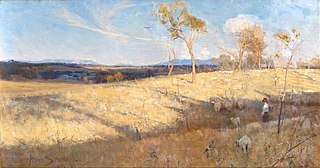
The Heidelberg School was an Australian art movement of the late 19th century. It has been described as Australian impressionism.

American Impressionism was a style of painting related to European Impressionism and practiced by American artists in the United States from the mid-nineteenth century through the beginning of the twentieth. The style is characterized by loose brushwork and vivid colors with a wide array of subject matters but focusing on landscapes and upper-class domestic life.
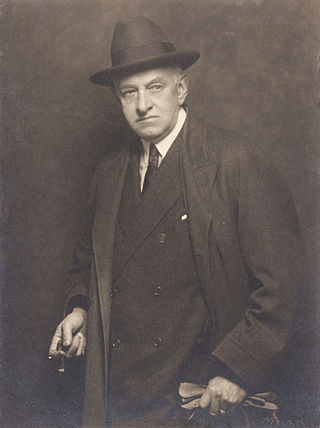
Willard Leroy Metcalf was an American painter born in Lowell, Massachusetts. He studied at the School of the Museum of Fine Arts, Boston, and later attended Académie Julian, Paris. After early figure-painting and illustration, he became prominent as a landscape painter. He was one of the Ten American Painters who in 1897 seceded from the Society of American Artists. For some years he was an instructor in the Women's Art School, Cooper Union, New York, and in the Art Students League, New York. In 1893 he became a member of the American Watercolor Society, New York. Generally associated with American Impressionism, he is also remembered for his New England landscapes and involvement with the Old Lyme Art Colony at Old Lyme, Connecticut and his influential years at the Cornish Art Colony.

Lilla Cabot Perry was an American artist who worked in the American Impressionist style, rendering portraits and landscapes in the free form manner of her mentor, Claude Monet. Perry was an early advocate of the French Impressionist style and contributed to its reception in the United States. Perry's early work was shaped by her exposure to the Boston School of artists and her travels in Europe and Japan. She was also greatly influenced by Ralph Waldo Emerson's philosophies and her friendship with Camille Pissarro. Although it was not until the age of thirty-six that Perry received formal training, her work with artists of the Impressionist, Realist, Symbolist, and German Social Realist movements greatly affected the style of her oeuvre.

William Merritt Chase was an American painter, known as an exponent of Impressionism and as a teacher. He is also responsible for establishing the Chase School, which later became the Parsons School of Design.

Frank Weston Benson, frequently referred to as Frank W. Benson, was an American artist from Salem, Massachusetts known for his Realistic portraits, American Impressionist paintings, watercolors and etchings. He began his career painting portraits of distinguished families and murals for the Library of Congress. Some of his best known paintings depict his daughters outdoors at Benson's summer home, Wooster Farm, on the island of North Haven, Maine. He also produced numerous oil, wash and watercolor paintings and etchings of wildfowl and landscapes.

Jane Peterson (1876–1965) was an American Impressionist and Expressionist painter. Her works use broad swaths of vibrant colors to combine an interest in light and in the depiction of spontaneous moments. She painted still lives, beach scenes along the Massachusetts coast, and scenes from her extensive travels. Her works are housed in museums such as the Metropolitan Museum of Art, the Museum of the City of New York, the National Museum of Women in the Arts and the Hirshhorn Museum in Washington D.C., and the Pennsylvania Academy of the Fine Arts and the Philadelphia Museum of Art in Philadelphia, Pennsylvania. She was a fellow of the National Academy of Design and taught at the Art Students League from 1913 to 1919. During her lifetime, Peterson was featured in more than 80 one-woman exhibitions.
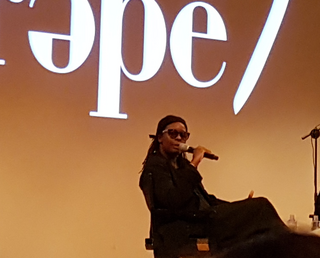
Mickalene Thomas is a contemporary African-American visual artist best known as a painter of complex works using rhinestones, acrylic, and enamel. Thomas's collage work is inspired from popular art histories and movements, including Impressionism, Cubism, Dada, the Harlem Renaissance, and selected works by the Afro-British painter Chris Ofili. Her work draws from Western art history, pop art, and visual culture to examine ideas around femininity, beauty, race, sexuality, and gender.

Margaret Fitzhugh Browne was an American painter of portraits, indoor genre scenes, and still lifes.

The Copley Society of Art is America's oldest non-profit art association. It was founded in 1879 by the first graduating class of the School of the Museum of Fine Arts and continues to play an important role in promoting its member artists and the visual arts in Boston. The Society is named after the renowned John Singleton Copley. The gallery currently represents over 400 living artist members, ranging in experience from students to nationally recognized artists and in style from traditional and academic realists to contemporary and abstract painters, photographers, sculptors, and printmakers. Several of the artists working in the tradition of the Boston School of painters exhibit at the Copley Society of Art, along with the Guild Of Boston Artists a few doors down from the Copley Society of Art's Newbury Street location.

The Boston School was a group of Boston-based painters active in the first three decades of the twentieth century. Often classified as American Impressionists, they had their own regional style, combining the painterliness of Impressionism with a more conservative approach to figure painting and a marked respect for the traditions of Western art history. Their preferred subject matter was genteel: portraits, picturesque landscapes, and young women posing in well-appointed interiors. Major influences included John Singer Sargent, Claude Monet, and Jan Vermeer. Key figures in the Boston School were Edmund C. Tarbell, Frank Weston Benson, and William McGregor Paxton, all of whom trained in Paris at the Académie Julian and later taught at the School of the Museum of Fine Arts. Their influence can still be seen in the work of some contemporary Boston-area artists.
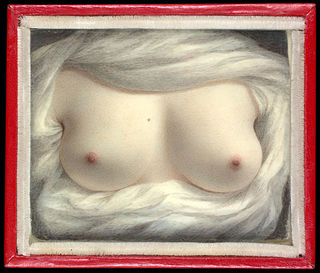
Beauty Revealed is an 1828 self-portrait by the American artist Sarah Goodridge, a watercolor portrait miniature on a piece of ivory. Depicting only the artist's bared breasts surrounded by white cloth, the 6.7-by-8-centimeter painting, originally backed with paper, is now in a modern frame. Goodridge, aged forty when she completed the miniature, depicts breasts that appear imbued with a "balance, paleness, and buoyancy" by the harmony of light, color, and balance. The surrounding cloth draws the viewer to focus on them, leading to the body being "erased".
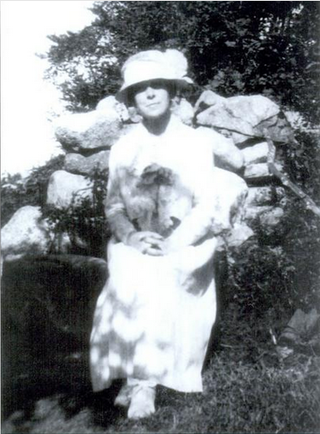
Mary Brewster Hazelton was an American portrait painter. She attended the School of the Museum of Fine Arts, Boston, where she was later an instructor. Among her other achievements, Hazelton was the first woman to win an award open to both men and women in the United States when she won the Hallgarten Prize from the National Academy of Design in 1896. Her portrait paintings are in the collections of the Massachusetts State House, Harvard University, Peabody Essex Museum, and Wellesley Historical Society. The professional organizations that Hazelton was affiliated with included the Wellesley Society of Artists, of which she was a founding member, and The Guild of Boston Artists, of which she was a charter member. She lived her adult life with her sisters in the Hazelton family home in Wellesley, Massachusetts.
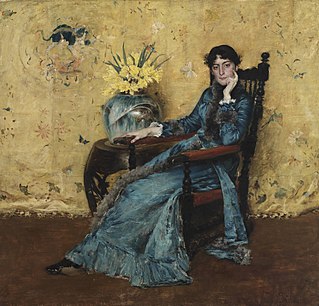
Dora Wheeler Keith, also known as Mrs. Boudinot Keith, was a portrait artist, muralist, designer and illustrator of books and magazines, and designer of tapestries for her mother Candace Wheeler's firm, the Associated Artists.
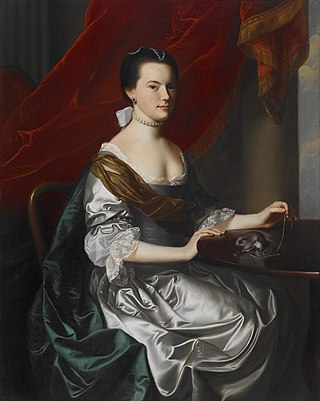
Mrs. Theodore Atkinson Jr. is an oil-on-canvas portrait painting completed in 1765 by the American artist John Singleton Copley. It is now housed in the Crystal Bridges Museum of American Art.

A Boy with a Flying Squirrel (Henry Pelham), or Henry Pelham (Boy with a Squirrel), is a 1765 painting by the American-born painter John Singleton Copley. It depicts Copley's teenaged half-brother Henry Pelham with a pet flying squirrel, a creature commonly found in colonial American portraits as a symbol of the sitter's refinement. Painted while Copley was a Boston-based portraitist aspiring to be recognized by his European contemporaries, the work was brought to London for a 1766 exhibition. There, it was met with overall praise from artists like Joshua Reynolds, who nonetheless criticized Copley's minuteness. Later historians and critics assessed the painting as a pivotal work in both Copley's career and the history of American art. The work was featured in exhibitions at the Museum of Fine Arts, Boston, and the National Gallery of Art. As of 2023, it is held by the former.
Mary Lewis Taylor Bryan was an American artist, known for her watercolor paintings. She was a prolific artist in watercolor and several other media and divided her time between Gloucester, Massachusetts, and Jeffersonville, Vermont.























